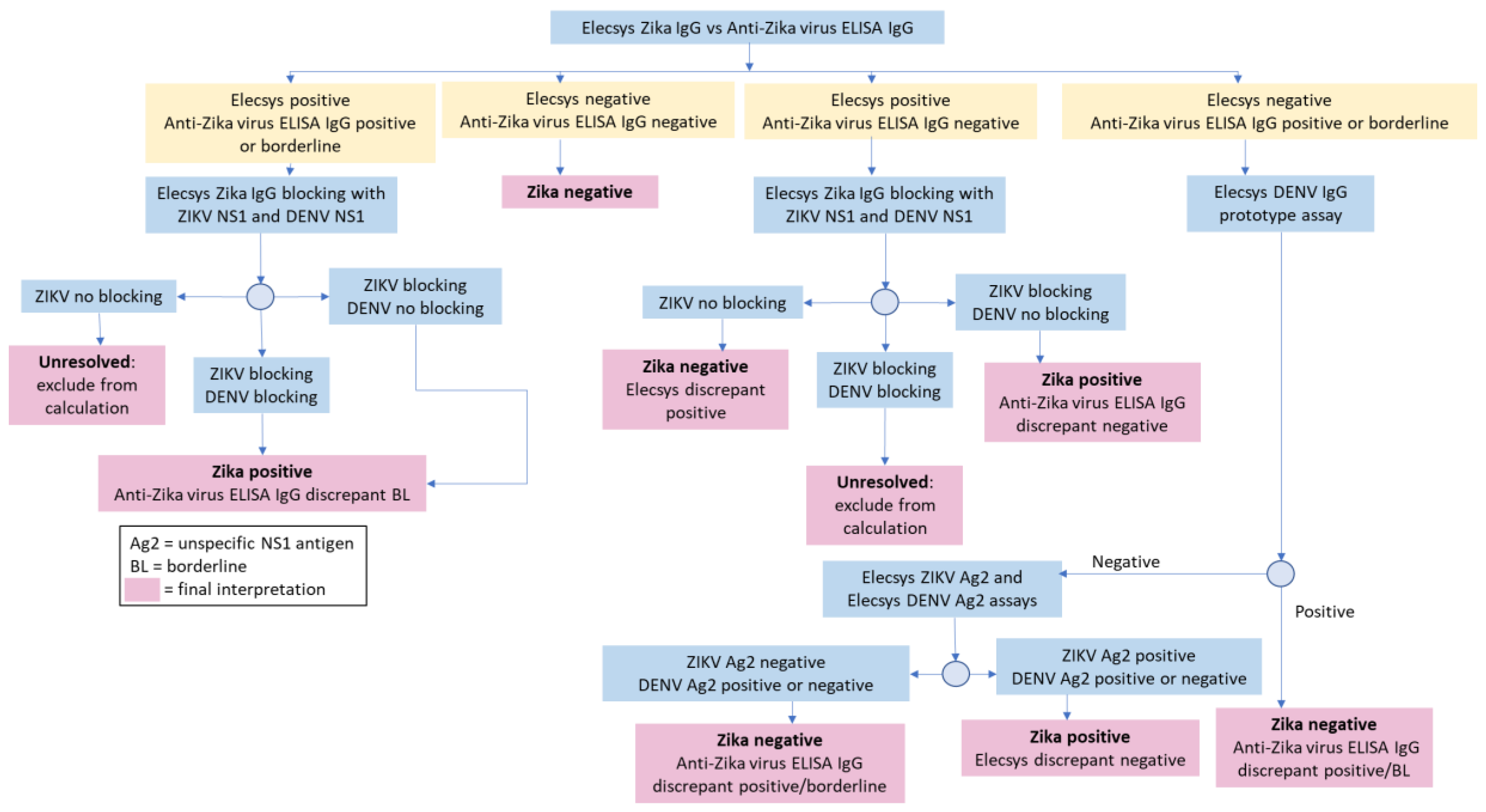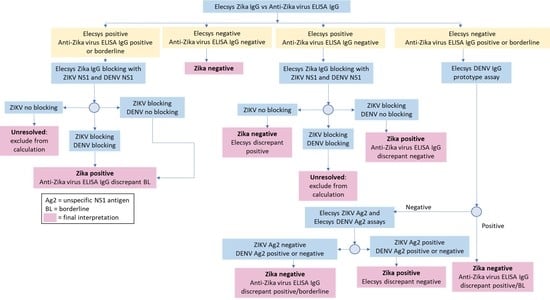Performance of an Automated Zika IgG Immunoassay in the Detection of Zika IgG Specific Antibodies—A Validation Approach in Samples from Prevalence Areas and Non-Endemic Countries
Abstract
:1. Introduction
2. Methods
2.1. Study Design
2.2. Samples
2.3. Methods and Analyses
3. Results
3.1. Diagnostic Performance
3.1.1. Zika Endemic Areas
3.1.2. Zika Non-Endemic Regions
3.2. Analytical Specificity
4. Discussion
Author Contributions
Funding
Acknowledgments
Conflicts of Interest
References
- Dick, G.W.; Kitchen, S.F.; Haddow, A.J. Zika virus. I. Isolations and serological specificity. Trans. R. Soc. Trop. Med. Hyg. 1952, 46, 509–520. [Google Scholar] [CrossRef]
- Dick, G.W. Zika virus. II. Pathogenicity and physical properties. Trans. R. Soc. Trop. Med. Hyg. 1952, 46, 521–534. [Google Scholar] [CrossRef]
- Simpson, D.I. Zika virus infection in man. Trans. R. Soc. Trop. Med. Hyg. 1964, 58, 335–338. [Google Scholar] [CrossRef]
- Lowe, R.; Barcellos, C.; Brasil, P.; Cruz, O.G.; Honório, N.A.; Kuper, H.; Carvalho, M.S. The Zika virus epidemic in Brazil: From discovery to future implications. Int. J. Environ. Res. Public Health 2018, 15, 96. [Google Scholar] [CrossRef] [PubMed] [Green Version]
- Spiteri, G.; Sudre, B.; Septfons, A.; Beauté, J.; The European Zika Surveillance Network. Surveillance of Zika virus infection in the EU/EEA, June 2015 to January 2017. Eurosurveillance 2017, 22, 17–00254. [Google Scholar] [CrossRef] [PubMed] [Green Version]
- Paixăo, E.S.; Teixeira, M.G.; Rodrigues, L.C. Zika, chikungunya and dengue: The causes and threats of new and re-emerging arboviral diseases. BMJ Glob. Health 2018, 3, e000530. [Google Scholar] [CrossRef] [PubMed] [Green Version]
- Musso, D.; Roche, C.; Robin, E.; Nhan, T.; Teissier, A.; Cao-Lormeau, V.M. Potential sexual transmission of Zika virus. Emerg. Infect. Dis. 2015, 21, 359–361. [Google Scholar] [CrossRef]
- Vouga, M.; Baud, D. Imaging of congenital Zika virus infection: The route to identification of prognostic factors. Prenat. Diagn. 2016, 36, 799–811. [Google Scholar] [CrossRef]
- Marano, G.; Pupella, S.; Vaglio, S.; Liumbruno, G.M.; Grazzini, G. Zika virus and the never-ending story of emerging pathogens and transfusion medicine. Blood Transfus. 2016, 14, 95–100. [Google Scholar]
- Duffy, M.R.; Chen, T.H.; Hancock, W.T.; Powers, A.M.; Kool, J.L.; Lanciotti, R.S.; Pretrick, M.; Marfel, M.; Holzbauer, S.; Dubray, C.; et al. Zika virus outbreak on Yap Island, Federated States of Micronesia. N. Engl. J. Med. 2009, 360, 2536–2543. [Google Scholar] [CrossRef]
- Ladhanim, S.N.; O’Connor, C.; Kirkbride, H.; Brooks, T.; Morgan, D. Outbreak of Zika virus disease in the Americas and the association with microcephaly, congenital malformations and Guillain-Barré syndrome. Arch. Dis. Child. 2016, 101, 600–602. [Google Scholar] [CrossRef] [PubMed] [Green Version]
- Singh, R.K.; Dharma, K.; Karthik, K.; Tiwari, R.; Khandia, R.; Munjal, A.; Igbal, H.M.N.; Malik, Y.K.; Bueno-Mari, R. Advances in diagnosis, surveillance, and monitoring of Zika virus: An update. Front. Microbiol. 2018, 8, 2677. [Google Scholar] [CrossRef] [PubMed] [Green Version]
- World Health Organization. Zika Epidemiology Update—July 2019. Available online: https://www.who.int/emergencies/diseases/zika/zika-epidemiology-update-july-2019.pdf?ua=1 (accessed on 2 January 2020).
- UNICEF Supply Division 2017. Zika Virus Diagnostics: Target Product Profiles & Supply Update. Available online: https://www.unicef.org/supply/files/Zika_Virus_Diagnostics_Target_Product_Profile_and_Supply_Note.pdf (accessed on 2 January 2020).
- Prasad, V.M.; Miller, A.S.; Klose, T.; Sirohi, D.; Buda, G.; Jiang, W.; Kuhn, R.J.; Rossmann, M.G. Structure of the immature Zika virus at 9 Å resolution. Nat. Struct. Mol. Biol. 2017, 24, 184–186. [Google Scholar] [CrossRef] [PubMed] [Green Version]
- Sirohi, D.; Chen, Z.; Sun, L.; Klose, T.; Pierson, T.C.; Rossmann, M.G.; Kuhn, R.J. The 3.8 Å resolution cryo-EM structure of Zika virus. Science 2016, 352, 467–470. [Google Scholar] [CrossRef] [Green Version]
- Singh, R.K.; Dhama, K.; Khandia, R.; Munjal, A.; Kumaragurubaran, K.; Tiwari, R.; Chakraborty, S.; Malik, Y.S.; Bueno-Mari, R. Prevention and control strategies to counter Zika virus, a special focus on intervention approaches against vector mosquitoes-current updates. Front. Microbiol. 2018, 9, 87. [Google Scholar] [CrossRef] [PubMed] [Green Version]
- EUROIMMUN. Zika Virus Infections EUROIMMUN Test Systems for the Diagnosis of Zika Virus Infections. Available online: https://www.euroimmun.com/documents/Indications/Infections/Zika-virus/HI_2668_I_UK_B.pdf (accessed on 2 January 2020).
- Mikrogen Diagnostik. recomLin Tropical Fever IgG. Available online: https://www.mikrogen.de/english/deutschland/products/product-overview/testsystem/tropical-fever-igg.html (accessed on 2 January 2020).
- Petersen, L.R.; Jamieson, D.J.; Powers, A.M.; Honein, M.A. Zika virus. N. Engl. J. Med. 2016, 374, 1552–1563. [Google Scholar] [CrossRef] [PubMed]
- Centers for Disease Control and Prevention. Testing for Zika Virus Infections. Available online: https://www.cdc.gov/zika/laboratories/types-of-tests.html (accessed on 2 January 2020).
- Landry, M.L.; St George, K. Laboratory diagnosis of Zika virus infection. Arch. Pathol. Lab. Med. 2017, 141, 60–67. [Google Scholar] [CrossRef] [Green Version]
- Fritzell, C.; Rousset, D.; Adde, A.; Kazanji, M.; Van Kerkhove, M.D.; Flamand, C. Current challenges and implications for dengue, chikungunya and Zika seroprevalence studies worldwide: A scoping review. PLoS Negl. Trop. Dis. 2018, 12, e0006533. [Google Scholar] [CrossRef] [Green Version]
- Xu, X.; Song, H.; Qi, J.; Liu, Y.; Wang, H.; Su, C.; Shi, Y.; Gao, G.F. Contribution of intertwined loop to membrane association revealed by Zika virus full-length NS1 structure. EMBO J. 2016, 35, 2170–2178. [Google Scholar] [CrossRef] [Green Version]
- Kikuti, M.; Tauro, L.B.; Moreira, P.S.S.; Campos, G.S.; Paploski, I.A.D.; Weaver, S.C.; Mitermayer, G.R.; Kitron, U.; Ribeiro, G.S. Diagnostic performance of commercial IgM and IgG enzyme-linked immunoassays (ELISAs) for diagnosis of Zika virus infection. Virol. J. 2018, 15, 108. [Google Scholar] [CrossRef]
- Safronetz, D.; Sloan, A.; Stein, D.R.; Mendoza, E.; Barario, N.; Ranandheera, C.; Scharikow, L.; Holloway, K.; Robinson, A.; Traykova-Andonova, M.; et al. Evaluation of 5 commercially available Zika Virus immunoassays. Emerg. Infect. Dis. 2017, 23, 1577–1580. [Google Scholar] [CrossRef] [PubMed]
- Rosenstierne, M.W.; Schaltz-Buchholzer, F.; Bruzadelli, F.; Có, A.; Cardoso, P.; Jørgensen, C.S.; Michiels, J.; Heyndrickx, L.; Ariën, K.K.; Fischer, T.K.; et al. Zika virus IgG in infants with microcephaly, Guinea-Bissau, 2016. Emerg. Infect. Dis. 2018, 2, 948–950. [Google Scholar] [CrossRef] [PubMed] [Green Version]

| Cohort | N | Positive or Borderline* Samples after Resolution | Negative Samples after Resolution | Unresolved Samples | Negative Discrepant Samples after Resolution† | Sensitivity (95% CI) | Specificity (95% CI) |
|---|---|---|---|---|---|---|---|
| Elecsys® Zika IgG | |||||||
| Suspected Zika infection from Latin America | 396 | 284 | 55 | 36 | 21 | 93.11 (89.67–95.69) | 100 (93.51–100) |
| Samples from Côte d’Ivoire | 100 | 3 | 96 | 0 | 1 | 75.00 (19.41–99.37) | 100 (96.23–100) |
| Total | 496 | 287 | 151 | 36 | 22 | 92.88 (89.42–95.48) | 100 (97.59–100) |
| Anti-Zika Virus ELISA IgG | |||||||
| Suspected Zika infection from Latin America | 396 | 305 | 21 | 36 | 34 | 100.00 (98.80–100) | 38.18 (25.41–52.27) |
| Samples from Côte d’Ivoire | 100 | 4 | 78 | 0 | 18 | 100 (39.76–100) | 81.25 (72.00–88.49) |
| Total | 496 | 309 | 99 | 36 | 52 | 100 (98.81–100) | 65.56 (57.40–73.10) |
| Cohort | N | Positive Samples after Resolution | Negative Samples after Resolution | Positive Discrepant Samples after Resolution | Specificity (95% CI) |
|---|---|---|---|---|---|
| Samples from Latin America before Zika epidemics | 94 | 2 | 92 | 0 | 100 (96.07–100) |
| Pregnant women in Europe | 500 | 0 | 500 | 0 | 100 (99.26–100) |
| European blood donors | 532 | 4 | 526 | 2 | 99.62 (98.64–99.95) |
| European blood donors with high TBE vaccination status | 559 | 0 | 559 | 0 | 100 (99.34–100) |
| Total | 1685 | 6 | 1677 | 2 | 99.88 (99.57–99.99) |
| Pathogen | N | Non-Reactive | Reactive |
|---|---|---|---|
| DENV | 30 | 30 | 0 |
| Cytomegalovirus | 12 | 12 | 0 |
| Epstein–Barr virus | 11 | 11 | 0 |
| Herpes simplex virus | 10 | 10 | 0 |
| Hepatitis A virus | 8 | 8 | 0 |
| Rubella virus | 12 | 12 | 0 |
| Hepatitis B virus | 11 | 11 | 0 |
| Hepatitis C virus | 12 | 12 | 0 |
| Plasmodium falciparum/vivax (malaria) | 11 | 11 | 0 |
| Treponema pallidium (syphilis) | 12 | 12 | 0 |
| Varicella zoster virus | 12 | 12 | 0 |
| TBE virus | 20 | 20 | 0 |
| Yellow fever virus | 15 | 15 | 0 |
| Japanese encephalitis virus | 3 | 3 | 0 |
| Antinuclear antibodies | 12 | 12 | 0 |
| Rheumatoid factor | 11 | 11 | 0 |
© 2020 by the authors. Licensee MDPI, Basel, Switzerland. This article is an open access article distributed under the terms and conditions of the Creative Commons Attribution (CC BY) license (http://creativecommons.org/licenses/by/4.0/).
Share and Cite
Laengin, T.; Augenstein, S.; Stadlbauer, E.; Girgnhuber, H.; Gloeck, M.; Riedel, A. Performance of an Automated Zika IgG Immunoassay in the Detection of Zika IgG Specific Antibodies—A Validation Approach in Samples from Prevalence Areas and Non-Endemic Countries. Trop. Med. Infect. Dis. 2020, 5, 97. https://doi.org/10.3390/tropicalmed5020097
Laengin T, Augenstein S, Stadlbauer E, Girgnhuber H, Gloeck M, Riedel A. Performance of an Automated Zika IgG Immunoassay in the Detection of Zika IgG Specific Antibodies—A Validation Approach in Samples from Prevalence Areas and Non-Endemic Countries. Tropical Medicine and Infectious Disease. 2020; 5(2):97. https://doi.org/10.3390/tropicalmed5020097
Chicago/Turabian StyleLaengin, Tina, Stephanie Augenstein, Elke Stadlbauer, Heike Girgnhuber, Mario Gloeck, and Alexander Riedel. 2020. "Performance of an Automated Zika IgG Immunoassay in the Detection of Zika IgG Specific Antibodies—A Validation Approach in Samples from Prevalence Areas and Non-Endemic Countries" Tropical Medicine and Infectious Disease 5, no. 2: 97. https://doi.org/10.3390/tropicalmed5020097
APA StyleLaengin, T., Augenstein, S., Stadlbauer, E., Girgnhuber, H., Gloeck, M., & Riedel, A. (2020). Performance of an Automated Zika IgG Immunoassay in the Detection of Zika IgG Specific Antibodies—A Validation Approach in Samples from Prevalence Areas and Non-Endemic Countries. Tropical Medicine and Infectious Disease, 5(2), 97. https://doi.org/10.3390/tropicalmed5020097





